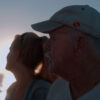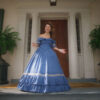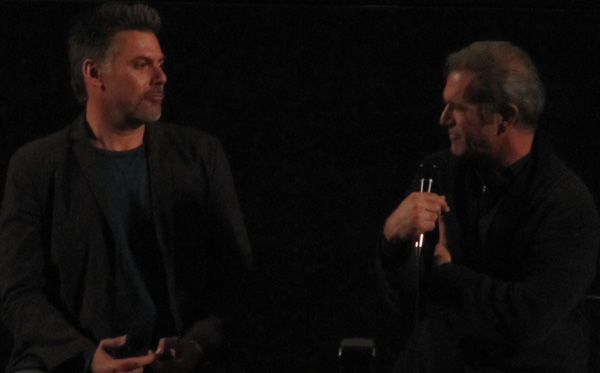Contrary to what some may suspect, Mel Gibson’s phone has not stopped ringing. In the midst of a nearly 45-minute conversation (of which the full video is now available online) with the actor/director following a screening of “Mad Max” on Saturday at the Egyptian Theatre in Hollywood, Gibson lost track of a question about how he felt about the venerable franchise when he slid his hand inside his coat pocket to check his phone.
“It’s TMZ,” teased moderator and Los Angeles Times writer Geoff Boucher, to which Gibson looked over the sold-out, 600-strong audience before responding, “I’m sure they’re here somewhere.”
It was one of just two allusions to Gibson’s personal travails in recent years, the other arriving later when Boucher, who was one of the last to do an in-depth profile of the actor circa 2010 when “Edge of Darkness” was released, asked whether he’s had trouble staying optimistic. Though the Q & A was never opened up for questions from the audience, Gibson needn’t have worried about an unfriendly crowd since there was rousing applause when he said, “Everybody gets ups and downs. It’s either sink or swim or you just don’t wake up one morning. But I kept waking up, so I figured what the f—?”
While Gibson appeared to be slightly guarded, he also was clearly appreciative of the opportunity to just talk about his films, which wasn’t limited to the “Mad Max” series despite the fact the evening’s triple bill also included “Road Warrior” and “Beyond Thunderdome.” Still, he fondly recalled how the franchise was “an education,” reminiscing about the fluky way he was first cast as the merciless Mad Max Rockatansky after taking his drama school flatmate Steve Bisley (who plays Max’s partner Jim Goose) to the audition after “I’d been out on the turfs about a week before and really had gotten into some serious trouble.” Roughed up, Gibson intrigued the casting department, who took polaroids of him and said, “Come back when you heal up. We’re looking for freaks.” When he came back three weeks later, they didn’t recognize him until he pointed to his Polaroid on their board and then won over producers by telling a joke and confirming he could drive.
Of course, Gibson would steer “Mad Max” towards being one of the highest grossing independent films of all time, scraped together on a budget of $300,000 from friends and relatives by first-time director George Miller and producing partner Byron Kennedy after the two were inspired by Miller’s experience of scraping bodies off the road as a medical student in New South Wales. The combined inexperience of all involved led to things in the first two productions that Gibson could only describe as “odd,” such as when, for instance, Miller argued with his cameraman about an illogical camera position on “Mad Max” or on “Road Warrior” where in the middle of the truck chase, an actor can be seen in the middle of the frame, “looking at the camera going, “I wonder if they can see me” that made the locked final cut. (On the other hand, Gibson confirmed the skill of the filmmakers on that same scene in “Road Warrior” when he collectively blew the minds of most of the audience when he said no one was actually moving during most of the filming of that chase.)
Yet Gibson had nothing but fond memories for those days, warmly recalling how locals in the mining village of Broken Hill where “Road Warrior” was shot thought he was strange for driving a Mini and wearing bedroom slippers around town and that Tina Turner was kind to him on the set of “Beyond Thunderdome” and she looked “really hot in that chainmail negligee” despite the crew ironically calling her “grandma.” He cited “Road Warrior as his favorite of the films, since he liked how it was almost a silent film and “with the benefit of the first one, I think they made the film they wanted to make in the first place” and though “Beyond Thunderdome” is the least appreciated of the three, he didn’t dismiss it, but he did acknowledge it went in a different direction after original producer Kennedy died in a helicopter crash before production and “George was really affected by it. It was an attempt to do something else, but I don’t know that it knew what it wanted to do.”
As for a fourth installment, Gibson said there was no thought of one during the ‘80s, but when Boucher pressed him on his involvement in the long-gestating “Fury Road,” he was careful not to give details while saying “it looked amazing” when he and Miller were planning to make it together eight years ago. Now that “Warrior” star Tom Hardy is onboard, along with Charlize Theron, Gibson appeared happy to pass the torch, saying he met with Hardy, “a firecracker” and “a very interesting actor [who] reminds me of one of my sons,” about six months ago for lunch where Hardy “maybe [asked] was is it okay?” and Gibson replied “Sure. It’s fine. Knock yourself out. I’ve got better things to do.”
Gibson said that last part with a smirk and added, “I’ve got a couple things on the boil.” That led Boucher to ask about two projects Gibson’s had in development, including his controversial collaboration with “Basic Instinct” scribe Joe Eszterhas for “The Maccabees,” about the Jewish army that he described simply as “an amazing story” and implored the audience to read “the last two books of the Old Testament, Maccabees one and two. It’s like a western.”
He would go into far more detail about “Berserker,” the Viking epic that once had Leonardo DiCaprio attached to star from a script by “The Departed” writer William Monahan, since he received a second draft of it the morning of the “Mad Max” screening. Those two are no longer on the film — Gibson said vaguely, “Things begin and then people wander off and do their thing and I do my thing. Where it goes from here is anybody’s guess.” Yet he added that he’s since worked on the script with “Braveheart” writer Randall Wallace from “the very first film idea I ever had,” describing how when he was 17 he studied Old Norse culture in his high school English class and was fascinated by the imagery and what it might sound like. “Then I slapped myself upside my head and said what do I know about making films?” Now that isn’t a stumbling block for Gibson, he said that the biggest question now was “how do you make a story about this particular culture,” after acknowledging to the approval of the crowd that “Vikings are very unsympathetic characters and these guys will be bad.” (And alas, Gibson clarified the helmets will not have horns – “They’re going to look real,” he said. “They’re not going to be running around like the ‘50s.)
However, those waiting for the bloody violence of “The Passion of the Christ” or “Apocalypto” might want to adjust their expectations since Boucher asked Gibson if as one of the central themes of his work if his “internal conversation” about violence has changed over the years. After some consideration, Gibson said it did change and said “there’s people far better at presenting it than I am.” He got a laugh when he continued to say, “There’s an art to that, kind of like the art of torture,” but added seriously, “The further we go, the less I want to see. It’s actually started to make me sick. But some is necessary. It’s a part of life.”
When asked if he preferred directing to acting, Gibson didn’t hesitate to say, “The most fun you can have standing up is directing” after he admitted about acting, “I guess I made my bones that way, but I don’t really think that that’s my forte. I much prefer to be behind the camera.” He went on to describe his goals as a filmmaker being “the three Es” – to entertain, to educate and to elevate – and “if you can do all those things together, you’re cooking.”
Another highlight of the evening was when Gibson shared an anecdote about when he was an up-and-coming actor that “still had the kangaroo shit on his shoes” and attended a party in New York with “Gallipoli” co-star Mark Lee where Andy Warhol had his eye on the pair and snapped their photo as he turned away, making them both wonder about “the guy with the dodgy wig taking pictures of us.” At the same soiree, Gibson met Truman Capote, who was “surrounded by really beautiful girls and had a black hat and a cloak and sunglasses on at night.” He replicated Capote’s withering voice when he said that when the famous author offered his hand and said, “I’m pleased to meet you,” and thought it was odd that when he met Marlon Brando a decade later, “He looked and sounded exactly the same.”
Then again, as Gibson added, “As we age, I keep mistaking myself for Sean Penn. I told him that the other night and he thought it was amazing too.”




